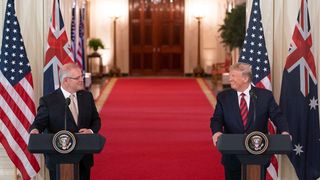At a conference in Los Angeles in January 2017, shortly after Donald Trump's inauguration, Kim Beazley recommended that the way Australia ought to manage its relationship with the United States under the new administration was to "grab them by the lapels and pull them in closer than ever". This seems to have been exactly what Australia has done, using levers as diverse as Greg Norman, Anthony Pratt and the Australian embassy's PR campaign trumpeting "100 years of mateship" between Australia the US.
Scott Morrison's official visit to Washington is one of the highlights of this campaign, a fitting capstone to Joe Hockey's tenure as ambassador. The Prime Minister departs Washington with Australia's credentials as an ally and partner of the US stronger than ever.
But the visit is a case of the Americans grabbing Australia by the lapels, reminding Morrison - and Australia - of how much they value the deep and broad US-Australia relationship.
The visit is better understood as an American investment in the longer-term health of the relationship, an affirmation of how deeply the US values Australia, when many in Washington fret about Australia's economic dependence on China.
Ahead of the visit, many journalists were asking me about what would be the quid pro quo. What do the Americans want of us? A harder line on China? A bigger commitment to the Strait of Hormuz? But it would seem there was no big public ask. Instead, the visit is better understood as an American investment in the longer-term health of the relationship, an affirmation of how deeply the US values Australia, when many in Washington fret about Australia's economic dependence on China.
The visit helped to reaffirm and recommit to the foundations of our relationship with the US. On this dimension Morrison excelled. His speechwriters deserve credit and Morrison's delivery was perfect. His South Lawn welcome speech was especially strong. After the now standard - yet always poignant - recitation of a long history of shared sacrifice and valour, Morrison provided one of the more powerful and succinct statements of the rationale for the Australian-US relationship. Australia and the US "see the world through a similar lens": principally, that "our lives, our fortunes and our sacred honour are founded in our willingness to stand for what we believe", including "that free and fair trade brings nations together, that governments derive their strength from the consent of the governed", that "the ballot box and democracy is the surest foundation for peace and security" and belief in "the rule of law and freedom of association."
China's expansion in the Indo-Pacific wasn't mentioned by name, but Morrison's intent was unambiguous. Indeed, the most frequently asked question about Australia in Washington is the level of Australian resolve in US-led strategic competition with China. Implicit in Morrison's words - and implicit by design - is reassurance to the Americans of Australia's commitment to protecting democratic institutions at home and in the Indo-Pacific.
In later events Morrison reminded Americans of the size of the investment relationship between Australia and the US, cumulatively worth $ 1.7 trillion, with the US Australia's largest source of investment, as well as the single largest destination for Australian international investment.
But here some gentle differentiation of Australian and US positions was introduced. Morrison reminded Americans that China is Australia's largest trading partner (as any American briefed on Australia well knows), that Australia has a comprehensive strategic partnership and a free trade agreement with China, and that for all the reaffirmations of the depth of Australia's friendship and its alliance with the US, Australia will always act in its national interest, as will the US (read: "there are limits to how much we will upset our trade relationship with China in the pursuit of interests we share with the United States").
In the Oval Office, American journalists were bellowing questions about the latest scandal to beset the Trump administration, the revelation that Trump may have asked Ukraine's government for assistance in digging up dirt on Joe Biden. That and the escalation of sanctions against Iran and the pending deployment of troops and materiel to Saudi Arabia meant the Morrison visit barely pierced the consciousness of the American news media.
But no matter. The pomp and ceremony of such visits - the intense focus on leader-to-leader interactions and their relationship - are important, but are really the tip of the iceberg. Strategic competition with China and a renewed focus on the Indo-Pacific has made Australia very relevant in Washington, as evidenced by the intensity of the work being done by Australian diplomats and, I might add, the level of interest in the work of the United States Studies Centre in Sydney.
With Morrison on his way to other US destinations (Ohio, Chicago and New York), this work resumes where the high-level visit leaves off. Are there any circumstances in which Australia would join US freedom-of-navigation operations in the South China Sea? Will US defence spending and force posture match its strategic aspirations for a free and open Indo-Pacific? What steps are Australia and the the US going to take to make the Western allies less reliant on Chinese supplies of critical minerals? What infrastructure projects will Australia and the US undertake together in the Indo-Pacific - consistent with offering regional partners an alternative to China's Belt and Road Initiative - and what role for private capital? Will the Trump administration be less sceptical - if not hostile - towards multilateral agreements of immense economic and strategic value, such as the Comprehensive and Progressive Agreement for Trans-Pacific Partnership?
The state visit didn't produce anything really new on these matters, some of the big questions confronting the US-Australia relationship.






